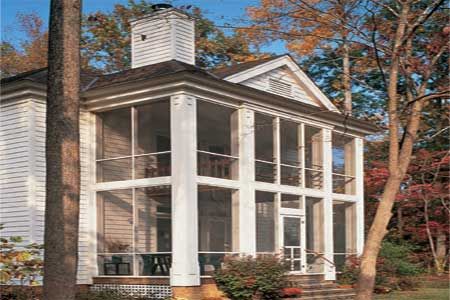Screening rooms offer the perfect blend of indoor comfort and outdoor living. These versatile spaces provide a retreat from the elements while maintaining a connection to the surrounding environment.
Whether you’re looking to create a cozy nook for relaxation or a spacious area for entertaining, a well-designed screening room can significantly enhance your home’s livability and value. In this comprehensive guide, we’ll explore everything you need to know about creating and enjoying your new indoor-outdoor space.
What Is a Screening Room?
A screening room is an enclosed outdoor space that combines the best aspects of indoor and outdoor living. These rooms are designed to keep insects out while allowing fresh air and natural light to flow freely.
Unlike traditional open porches, screening rooms offer protection from insects and light rain. They also provide more privacy and can be used for a wider range of activities throughout the year. The enclosed nature of screening rooms allows for more comfortable furnishings and decor options, making them true extensions of your home’s interior living spaces.
John Hopke, an architect in Williamsburg, Virginia, says almost every new home built in his area includes an outdoor deck—but because of the insects, they’re rarely used. “People know the mosquitoes are bad and that they won’t be using the deck until it’s screened in,” he notes, joking, “Around here, another word for ‘deck’ is ‘future screened porch.’” When Hopke built his own 2,350-square-foot home, he opted to skip the deck stage and invest in a screened porch.
Types of Screening Rooms
Screening rooms come in various forms, each with its own unique characteristics and benefits.
- Enclosed porches: Enclosed porches are the most common type of screening room. They typically feature large screen panels on all sides, allowing for maximum airflow and visibility, and can be designed to complement your home’s architecture.
- Sunrooms: Sunrooms are fully enclosed spaces with large windows or glass panels instead of screens. While not technically “screening rooms,” they offer similar benefits with added protection from the elements and often feature climate control options.
- Screened-in decks: If you have an existing deck, converting it into a screened-in space is a popular option, especially in areas with high insect populations. It provides a protected space for relaxation, dining, and entertainment.
- Screened gazebos: Screened gazebos are freestanding structures that offer a charming and private retreat in your backyard. They typically feature a round or hexagonal shape and provide a bug-free haven for enjoying the outdoors.
- Three-season rooms: Three-season rooms are enclosed spaces designed for use during spring, summer, and fall. They are typically constructed with large screened openings and sometimes include windows that can be opened or closed depending on the weather.
- Four-season rooms: Also known as solariums or conservatories, these rooms are insulated and equipped with heating and cooling systems for year-round use. They often feature expansive windows or glass walls to maximize natural light and views.
- Pool and patio enclosures: These enclosures are designed to extend the usability of your pool or patio area, making them enjoyable for more months of the year. They can be constructed with screens, glass, or a combination of both.
- Screen balconies: Screened balconies are a practical way to add functional outdoor space to apartments or multi-story homes. They provide a private and protected area for relaxation and enjoying the view, even in urban areas.
Designing Your Screening Room
The best screening rooms are not simply add-ons but thoughtfully designed extensions that enhance both the form and function of your home. Here are some things to think about when creating your perfect indoor-outdoor haven.
Architectural Style
Your screening room should be a functional space—and a seamless extension of your home’s architecture. Consider elements such as roof pitch, column design, and trim details to create a cohesive look that complements your existing style. For instance, Gary Wolf, an architect in Boston, designed a wraparound screened porch for a century-old stucco home, incorporating elements that echoed the house’s character while providing modern functionality.
Choosing the Right Location
The placement of your screening room can significantly impact its usability. Take into account factors such as sun exposure, prevailing winds, and views when deciding where to build. A south-facing room can capture warmth in cooler months, while a north-facing orientation may offer relief from intense summer heat. Additionally, consider the surrounding landscape and how it can enhance the overall ambiance of your screening room.
Size and Layout Planning
The size of your screening room should be proportionate to both your home and your lot size. A massive enclosure on a small property can feel overwhelming, while a tiny addition to a sprawling estate might seem insignificant.
When determining the layout, consider how you plan to use the space. If you envision hosting dinner parties, ensure there’s ample room for a dining table and comfortable seating. If relaxation is the primary goal, prioritize ample lounging space and perhaps a cozy fireplace. Remember to account for traffic flow and furniture placement in your design to ensure a functional and inviting space.
Selecting the Best Screening Materials
The choice of screening material can significantly impact the appearance, durability, and functionality of your screening room. Here’s how the most popular options compare:
| Material | Pros | Cons | Cost* (per square foot) |
| Fiberglass | Most economical, lightweight, won’t rust | Less durable, needs frequent replacement | $0.25–$0.50 |
| Aluminum | More durable than fiberglass, available in various colors | Less durable than bronze or copper | $0.35–$0.70 |
| Copper | Resistant to salt spray, distinctive look | More expensive than aluminum | $1–$1.50 |
| Specialty screens | Super-strong, pet-resistant, sun-control options available | More expensive than standard options | Varies |
Note: Cost data for this article was sourced from contractor estimates used by Angi.
Construction and Installation Process of Screening Rooms
The construction and installation of a screening room can vary depending on the complexity of the design and whether you’re adding a new structure or modifying an existing space.
DIY vs. Professional Installation
If you want to screen an existing porch or deck, you can save $1,200–$2,000 on labor costs by DIYing the job. However, we recommend professional installation for more complex projects, such as building a brand-new porch. Professional installers can ensure proper structural support, weatherproofing, and seamless integration with your home’s existing architecture.
Timeline and Cost Estimates
The timeline for constructing a screening room can range from a few days for a simple screened-in porch to several weeks for a more elaborate custom design. Costs can also vary widely based on size, materials, and complexity.
Most homeowners pay between $25 and $120 per square foot to build a screen porch while screening in an existing porch costs $5–$20 per square foot. Angi estimates the total cost for a 12-by-12-foot porch at $7,200 if you’re building one from scratch or $2,000 if you’re just adding a screen.
We recommend getting quotes from several contractors to estimate the cost for your specific project.
Furnishing and Decorating Your Screening Room
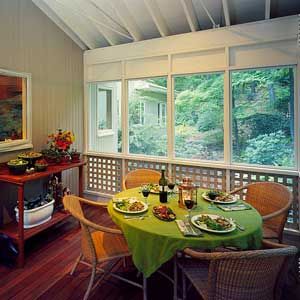
Once your screening room is built, furnishing and decorating it will transform it into a comfortable, inviting space. Here are a few things to consider:
- Weather-resistant furniture: Choose furniture that can withstand exposure to humidity and temperature fluctuations. Outdoor-rated furniture made from materials like teak, aluminum, or all-weather wicker is ideal. Consider adding weatherproof cushions for comfort and style.
- Lighting and accessories: Proper lighting can extend the usability of your screening room into the evening hours. Consider a combination of ambient lighting, such as ceiling fans with light fixtures, and task lighting for reading or dining areas. Outdoor-rated rugs, throw pillows, and curtains can add warmth and personality to the space.
- Plants and greenery: Incorporating plants into your screening room design can enhance the connection to nature. Choose plants that thrive in your local climate and can tolerate the specific light conditions of your screening room. Hanging baskets, potted plants, and even small trees can create a lush, inviting atmosphere.
- Climate control: For extended seasonal use, consider adding ceiling fans, portable heaters, or even a mini-split HVAC system. These additions can significantly extend the usability of your screening room throughout the year.
- Entertainment systems: To create an outdoor entertainment area, incorporate weather-resistant speakers or a television. Ensure all electronics are properly protected from the elements and installed according to local building codes.
- Privacy screens: If your screening room is visible to neighbors, consider adding privacy screens, outdoor curtains, or strategically placed plants to create a more secluded atmosphere.
Real-Life Screening Room Transformations
To give you a little more inspiration, we rounded up a few real-world examples that showcase the versatility of screening rooms.
A Two-Story Victorian-Inspired Retreat
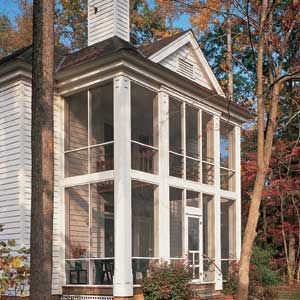
In Williamsburg, Virginia, Hopke designed a unique two-story screened enclosure for his family home. The upper porch offers a private retreat for Hopke and his wife, while the lower porch serves as a spacious gathering area for the entire family.
Hopke drew inspiration from the area’s many Victorian homes to create what he calls a “transitional” style: “traditional enough for the market but contemporary enough to suit me.” Tradition is evident in the four 22-foot columns on the south side of the home. These columns provide the framework for the two-story screen enclosure, integrating seamlessly with the home’s architecture.
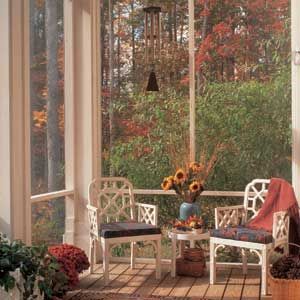
Both porches catch the sun that falls on the south side of the home. “They provide effective shading when it’s hot,” says Hopke, “and during the winter months, when the sun is lower in the sky, you still get good sunlight through them. They cast nice shadows in the wintertime.”
The upper porch occupies only the center third of the space above the lower porch, with 17 feet of open space stretching from the lower floor to the ceiling on either side. That meant the furniture for the upper porch didn’t have to be carried through the house—instead, it was hoisted up through the openings.
A Kitchen-Connected Treehouse Oasis
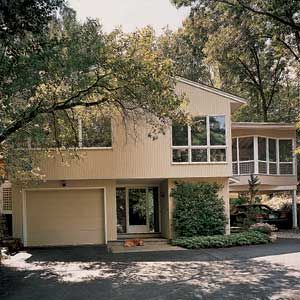
In Weston, Massachusetts, Richard and Darcy Lettieri added a screened porch to their home during a kitchen remodel. The porch, perched atop a new carport, provides a comfortable outdoor eating area off their second-floor kitchen.
Its unique angled bay adds architectural interest and expands the usable area, making it a perfect spot for enjoying meals and socializing. “It’s a very square-shaped house,” says Darcy, “and one of the things I asked for was something without a 90-degree angle in it.” Their architect, Gary Wolf of Boston, obliged by designing an angled bay on the front of the porch.
Not only does the bay “give the porch some identity from the outside,” as Wolf puts it, but it also provides enough extra space in the 200-square-foot porch to add a seating area. Space was a particular issue in this case because of zoning setback requirements and the compact size of the remodeled kitchen, which a large porch would have overpowered.
Besides the kitchen door that opens onto the porch, Wolf added a pair of casement windows looking out from the kitchen—”a nice way of connecting the interior and exterior space,” he says. The windows are also convenient for passing food and dishes back and forth during alfresco family gatherings.
A Light-Filled Wraparound Haven
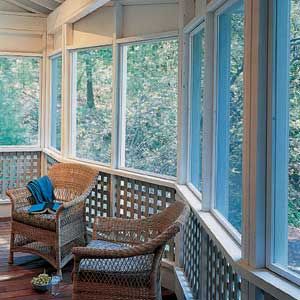
Wolf also designed a wrap-around screened porch for a family renovating their century-old home in suburban Boston. The porch replaced a cramped family room and a bug-infested deck with a much larger family room inside and a 450-square-foot screened porch outside.
The screened porch evokes a similar structure the family had once enjoyed at their former vacation home in Maine. It runs behind the family room and kitchen, along the entire northern edge of the house, and then turns the corner on the back of the house, where a stairway leads down to a garden.
Dense trees and the northern orientation made it tricky to get enough natural light into the space. However, Wolf solved the problem with four skylights and free-form cutouts in the marine-grade mahogany plywood panels fitted over and under the fiberglass screens. “I was trying to find a way to give a sense of enclosure while capturing some of the quality of being in a tree house, where you have light filtering in through the trees and creating interesting shadows,” says Wolf.
Maintenance and Care Tips for a Screening Room
Regularly clean your screens to maintain visibility and airflow. Use a soft brush or vacuum attachment to remove dust and debris, and occasionally wash the screens with mild soap and water. Avoid using harsh chemicals that could damage the screen material.
As the seasons change, prepare your screening room by inspecting for any damage, tightening loose screws or fasteners, and cleaning thoroughly. In colder climates, you may need to store or cover furniture during winter months.
If you notice any tears or holes in screens, address them promptly to prevent further damage and maintain the room’s insect-free environment. Keep spare screening material on hand for quick repairs, or contact a professional for larger repairs or full-screen replacements.
Our Conclusion
Screening rooms offer a unique opportunity to blend indoor comfort with outdoor living, creating a versatile space that can be enjoyed throughout much of the year. By carefully considering design elements, choosing appropriate materials, and incorporating thoughtful furnishings and accessories, you can create a screening room that becomes a favorite retreat for relaxation and entertainment.
Where to find it:
